Alice Neel: A Chronicle of New York 1950 - 1976
Intimate, casual, direct and personal, Alice Neel's portraits are a chronicle of New York types. From her foundations as an artist of social commitment engaged in the government-sponsored Public Works of Art Project and Works Progress Administration Easel Division in the 1930s, Neel was always interested in social engagement. Moving from Greenwich Village to Spanish Harlem in 1938 she had been motivated to 'find more truth'. There she painted children on the street, her keen observation, tempered by subjectivism, contrasting with and complementing the work of such American documentary photographers as Berenice Abbott, Walker Evans and Helen Levitt. Portraits of friends and acquaintances, especially artists and writers, done before the model, and of people encountered by chance, painted from memory, became Neel's principal activity from the 1940s onwards.
In 1962 Neel moved from Spanish Harlem to the Upper West Side and from that moment onwards renewed her engagement with the New York art world. Invitations to exhibit that had previously been unforthcoming now became plentiful, culminating in a major retrospective exhibition at the Whitney Museum of American Art in 1974. A popular figure within art world circles, she painted many of its principal protagonists. Her portrait of Andy Warhol, painted two years after he had been shot, is a poignant and frank record of his physical state, expressing vulnerability and detachment.
Bringing together paintings from three decades, this exhibition shows the remarkable range of characters that Neel portrayed in paintings that demonstrate a rare combination of painterliness and acute draughtsmanship. Clothes, gestures, expressions and personalities are closely observed and perceptively summarised in a body of work that draws on sources as various as Beckmann, Balthus, Manet and Matisse. Alternating between sombre and vibrant colours, Neel's application of paint could be hard-edged and broad as she addressed her subjects on canvas without preliminary sketches. The result of this direct approach was a series of paintings that preserved the spontaneity of initial ideas and the liveliness of the one-to-one encounter.
Alice Neel was born in Merion Square, Pennsylvania in 1900 and attended the Philadelphia School of Design for Women. She had four children. The first child died of diphtheria in 1927; her second child was removed from her care three years later prompting attempts at suicide. She later gave birth to two sons whom she brought up more or less single-handed while pursuing her career as an artist. Experiencing a life of hardship - her early paintings were destroyed in a fit of peak by a former lover, she suffered a miscarriage in her sixth month of pregnancy and rarely sold work in her early years - she was an independent spirit who paid no attention to the fashions of art but whose work received true recognition late in her career. She died in 1984.
Alice Neel is widely collected and exhibited in America. Exhibitions include her centennial retrospective in 2000 - 2001 organised by the Philadelphia Museum of Art and shown at the Whitney Museum of American Art, New York and Walker Art Center, Minneapolis. Although Neel has been included in European anthologies, such as The Portrait Now (National Portrait Gallery 1993) and Masculinfeminin - le sexe de l'art (Centre Georges Pompidou 1995), this is the first Alice Neel exhibition to take place in Europe.
Exhibition organised by Victoria Miro Gallery in association with Jeremy Lewison Limited.
-

On view in Turin – Alice Neel: I Am the Century at Pinacoteca Agnelli
October 30 2025The first retrospective in Italy dedicated to Alice Neel, the exhibition (31 October 2025–6 April 2026) will highlight Neel’s pioneering gaze and interest in humanity in all its forms.Read More -

Hilton Als speaks to Dazed about At Home: Alice Neel in the Queer World
February 12 2025'Alice Neel gave us the opportunity to touch and understand each other, even if for a little bit.'Read More

